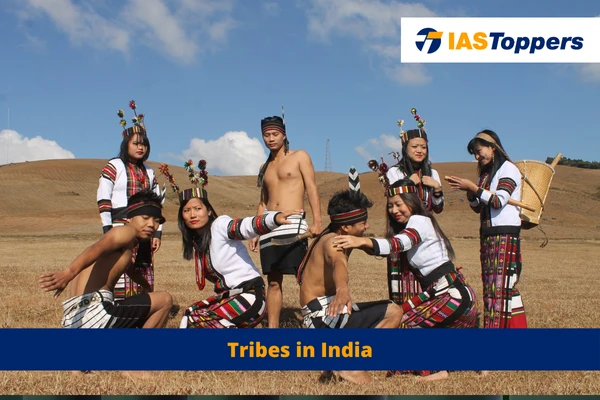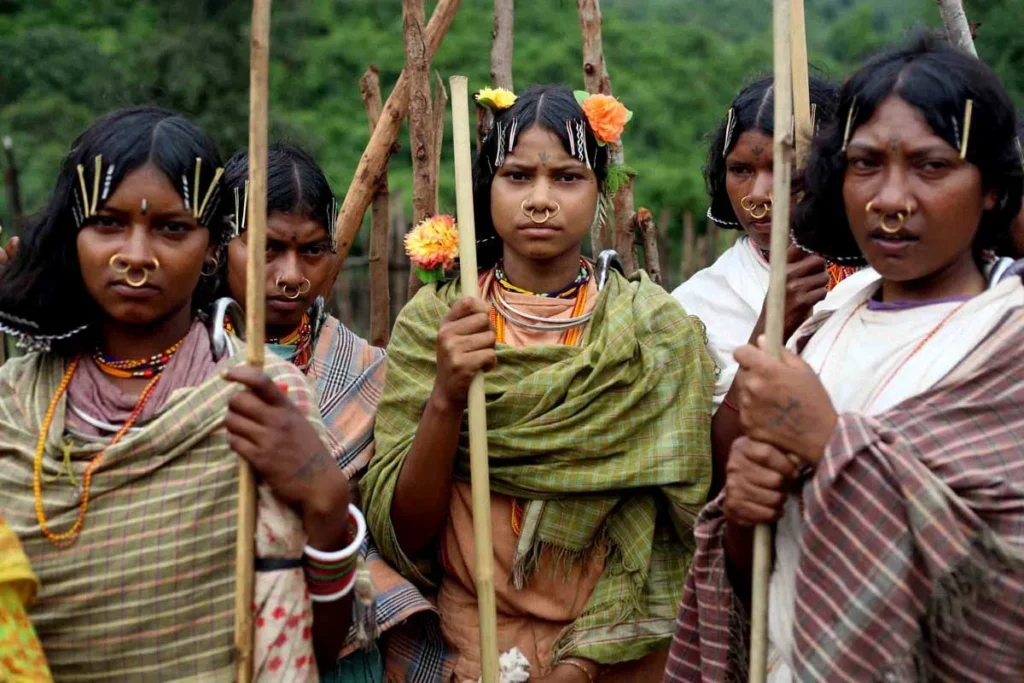Tribes in India are defined under Article 366 (25) of the Indian Constitution as “tribes or tribal communities or parts of or groups within such tribes or tribal communities that are deemed under Article 342 to be Scheduled Tribes (STs) for the purposes of this constitution”. In this article, you will learn about Tribes, their characteristics, history, safeguards provided by Indian Constitution, etc.
This article will provide key insights for GS Paper- II Polity and Governance of UPSC IAS Exam.
Table of Content
- Tribes
- Characteristics of Tribal Community
- Tribal Situation in India
- History of Tribes in India
- Safeguards provided by Indian Constitution for Scheduled Tribes
- Government Initiatives for Scheduled Tribes
- Challenges Faced by Tribes in India
- Methods to empower Tribes in India
- Conclusion
- Frequently Asked Questions
Tribes
- In India they are defined under Article 366 (25) of the Indian Constitution as “tribes or tribal communities or parts of or groups within such tribes or tribal communities that are deemed under Article 342 to be Scheduled Tribes (STs) for the purposes of this constitution”.
- Article 342 (i) of the Constitution states that the President may specify the tribes or tribal communities to be deemed as STs.
Characteristics of Tribal Community
- Common Territory: The tribe has a definite territory in which its members reside such as Naga in Nagaland, Bhils in Madhya Preadesh, etc.
- Collection of Families: Tribals constitute a collection of families, which normally have blood relationships among themselves whether matriarchal or patriarchal in nature.
- Common Name: Every tribe has its own name with each tribe known by its distinctive name.
- Common Language: The members of a tribe speak a particular language, which may often differ from one another.
- Common Ancestor: The tribals claim that they have a common ancestor, which is a major cause of the sense of communal unity in the tribe.
- Common Political Organisation: Each tribe has its own political system, with tribal chief normally exercising authority over all the other members.
Tribal Situation in India:
- The tribes of India constitute around 8.6% of the total Indian population (Census, 2011).
- Different tribes are recognized by different economic levels such as, the Negritos of the Andaman (Onge, Great Andamanese and Jarawa) are the semi-nomadic tribes, whereas the Todas of South India is a pastoral community.
History of Tribes in India:
Pre-independence approach by the British:
- It was more ameliorative in nature and used as an isolationist strategy to make the task of administration in the tribal areas easy by alienating them from the rest of the population.
- Britishers levied land revenue on tribals and encouraged land alienation policies.
Post-independence approach:
- It was more growth-oriented strategy, in which government declared some of the areas as “Scheduled Areas,” where the population of the tribals was more than 50%.
- Ministry of Tribal Affairs was set up in 1999 after the bifurcation of the Ministry of Social Empowerment and Justice, for a focused approach for the integrated development of the Scheduled Tribes (STs), in a planned and coordinated manner.
Safeguards provided by Indian Constitution for Scheduled Tribes
Political Safeguards:
- Article 330: It provides for the reservation of seats for SCs and STs in the House of the People.
- Article 332: It provides for the reservation of seats for SCs and STs in State Legislatures.
- Article 243: It provides for the reservation of seats for SCs and STs in Panchayats.
- Article 275: It provides for the grant of special funds by the Union to the State Government to promote the welfare of STs and providing them with a better administration.
- Fifth and Sixth Schedules: It provides for autonomous district councils with legislative, judicial, and administrative powers in certain tribal areas.
Educational & Cultural Safeguards:
- Article 15(4): Special provisions for advancement of other backward classes, including STs.
- Article 29: Protection of Interests of Minorities, including STs.
- Article 46: The State shall promote, the educational and economic interests of the weaker sections of the people, and particularly of the Scheduled Castes (SCs), and STs, and shall protect them from social injustice and all forms of exploitation.
- Article 350: Every person shall be entitled to submit a representation for the redress of any grievance to an authority of the Union or a State in any of the languages used in the Union or in the State.
Government Initiatives for Scheduled Tribes
- Forest Rights Act (2006): It recognizes the rights of forest-dwelling tribes to land and other resources.
- Panchayats (Extension to Scheduled Areas) Act (1996): It extends the provisions of the Panchayati Raj Act to Scheduled Areas, ensuring greater autonomy and self-governance.
- TRIFED (Tribal Co-operative Marketing Federation of India): It is a national-level apex organization functioning under the administrative control of Ministry of Tribal Affairs, for the socio-economic development of tribal people in the country.
- Pradhan Mantri Van Dhan Yojana: It was launched in 2018, to improve tribal incomes through value addition of tribal products.
- Eklavya Model Residential Schools (EMRS): It aims to provide quality middle and high level education to ST students in remote areas.
- Janjatiya Gaurav Divas: It is celebrated on 15 November (birth anniversary of Birsa Munda), to remember the contribution of tribal freedom fighters, as part of the year-long celebration of the 75th anniversary of Indian independence.
- Pradhan Mantri PVTG Development Mission: It aims to improve socio-economic conditions of PVTGs by saturating PVTG families and habitations with basic facilities.
- Pradhan Mantri Janajatiya Vikas Mission: It aims to strengthen tribal entrepreneurship initiatives and to facilitate livelihood opportunities.
- PM JANMAN (PM- Janjati Adivasi Nyaya Maha Abhiyan): It aims at comprehensive development of 75 PVTGs, who continue to lag behind in socio economic indicators of educational, health and livelihood.
- Pradhan Mantri Adi Adarsh Gram Yojna: It aims at transforming villages with significant tribal population.
- Minor Forest Produce (MFP): Implementation of the Minimum Support Price (MSP) for MFP ensures fair prices for tribal gatherers, promoting sustainable livelihoods.
Challenges Faced by Tribes in India
- Land Alienation: Tribal lands are often subject to encroachment and alienation due to development projects, mining activities, etc, leading to displacement, loss of livelihood, and cultural disintegration.
- Lack of proper Rehabilitation: Large-scale infrastructure projects often lead to the displacement of tribal communities, without adequate rehabilitation & resettlement measures.
- Loss of Control over Natural Resources: With the concepts of protected forests and national forests gaining currency, the tribals felt alienated over the resources they have been utilising from centuries.
- Poverty: Tribes are among the poorest sections of Indian society, who have limited access to productive resources, markets, and employment opportunities.
- Healthcare Issues: Tribal areas often lack adequate healthcare facilities, and suffers from high prevalence of diseases, such as sickle cell anaemia, high infant and maternal mortality rates, and low life expectancy.
- Education Challenges: Tribes often suffers low literacy rates, high dropout rates, and limited opportunities for higher education and skill development.
- Social Discrimination and Exclusion: Tribes are often the victims of practices like untouchability and social ostracism, leading to marginalization and exclusion from socio-economic and political processes.
- Cultural Erosion: Rapid modernization and external influences threatens the unique cultural identities, languages, and traditions of tribal communities, leading to loss of cultural heritage and traditional knowledge systems.
Methods to empower Tribes in India
- Enhancing Healthcare Services: Setting up mobile medical camps in remote tribal regions, providing emergency transport for pregnant tribal women, can help improve healthcare access.
- Boosting Food and Nutrition: Establishing Mini-Anganwadis with relaxed regulations and expanding Village Grain Banks in tribal areas are effective strategies can help reach underserved populations and enhance food security.
- Creating Jobs and Income: Ensuring employment opportunities, either through wages or self-employment can help improve the economic status of tribal communities and freeing them from poverty and debt.
- Managing Water Resources: Implementing the National Water Policy more effectively in tribal areas is crucial along with a focus on watershed management, rainwater harvesting, etc.
- Empowering Tribal Women: To uplift tribal women, measures should include promoting their leadership in Joint Forest Management and Panchayati Raj Institutions, among others.
- Cultivating Medicinal Plants: India leads in exporting generic medicines and hence tribes should be encouraged to work with the government in identifying, collecting, and cultivating medicinal plants for personal use and sale.
- Infrastructure Development: The government shall work with tribal groups to develop local infrastructure. Example: Khasi and Jaintia tribes in Meghalaya have mastered creating living root bridges.
Conclusion
In conclusion, the myriad tribes of India represent a rich tapestry of cultural diversity, each with its unique traditions, languages, and socio-economic structures. While these indigenous communities contribute significantly to the country’s cultural heritage and ecological preservation, they also face myriad challenges such as marginalization, displacement, and socio-economic disparities. Therefore, it is imperative for government policies to prioritize their rights, empower them economically, ensure their participation in decision-making processes, and preserve their cultural identities. Only through concerted efforts to address these issues can India truly achieve inclusive and sustainable development while honoring the invaluable contributions of its tribal communities.
Ref:Source-1
| Other Articles in History & Culture | |
| Classical Sanskrit Theatre | Left-Wing Movement in India |
| Ellora Caves | Pala Art and Architecture |
| Hoysala Empire | Hindustani Music |
FAQs (frequently asked questions)
How many tribes are there in India?
In India, 705 ethnic groups are recognised as Scheduled Tribes. In central India, the Scheduled Tribes are usually referred to as Adivasis, which literally means Indigenous Peoples.
Which is largest tribe in India?
Bhil is the largest tribal group in India as per 2011 Census.



